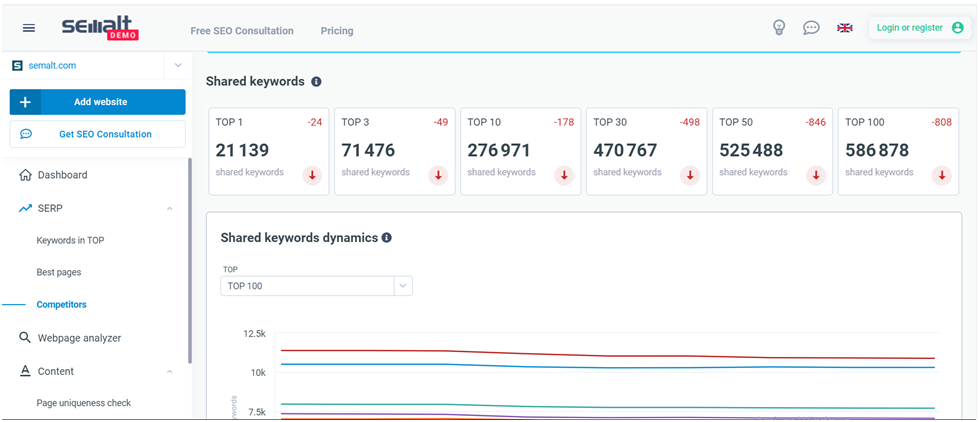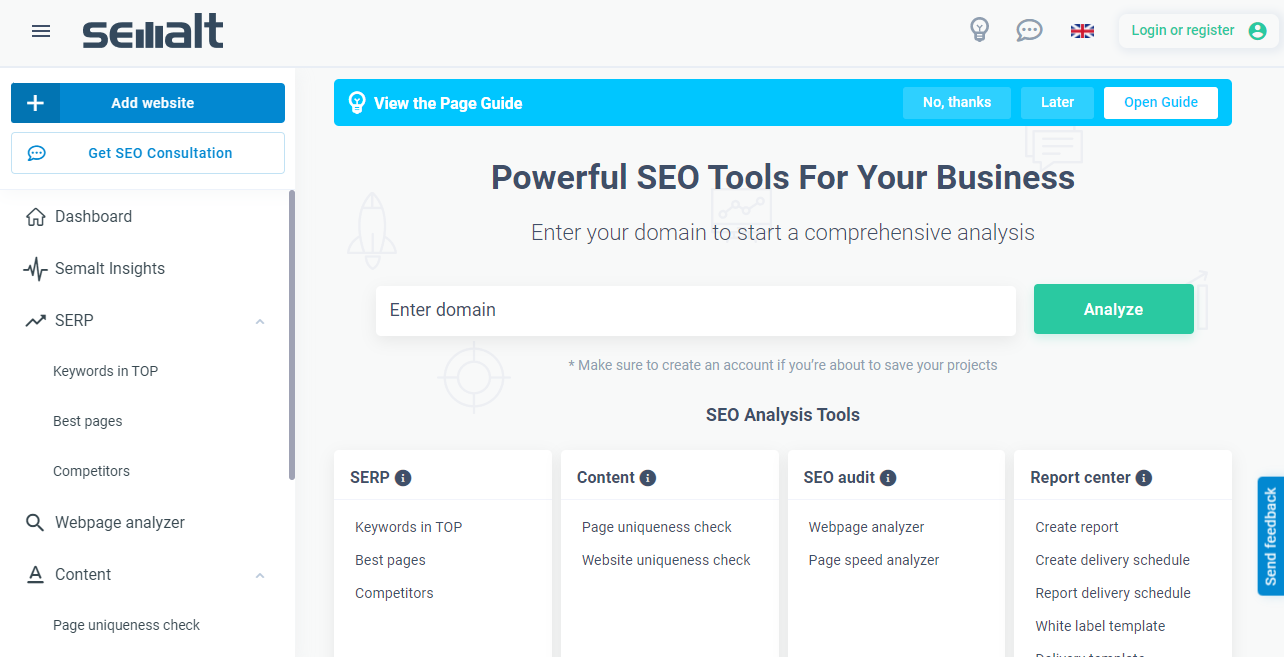Semalt E-Commerce SEO For Beginners

Understanding SEO is now a must for businesses as it generates leads and conversions. SEO is a digital marketing strategy that helps increase the amount and quality of traffic to your site. It stands for search engine optimization. SEO, which enables you to rank higher in search engines such as Google, requires you to make some adjustments to your website to get organic traffic. These regulations: What is E-Commerce SEO for businesses that want to increase their sales, brand awareness, and sectoral reputation? Require asking the question:
What is E-commerce SEO?
The results page that opens when we search on a search engine such as Google is called SERP. E-commerce SEO helps increase your sales by making your product pages appear among the top ten organic search results in the SERPs.
E-Commerce SEO, which allows you to get a share of search results aims to get you listed as high as possible for the search terms used by potential customers.
E-Commerce SEO strategies refer to basic SEO techniques such as site structure, technical SEO, keyword research, content strategy, on-page SEO, and link building and achieve success by focusing on user experience.
E-commerce SEO: it is not a simple strategy that gives quick results the moment you apply it. As with all digital marketing applications, it takes time. It can take a year for consistent traffic to build up on your site.
Why is E-commerce SEO Important?
Organic searches have become such an important sales channel that no one is surprised anymore by research showing that 92 percent of traffic goes to websites that appear on the first page of Google search.
However, of course, traffic does not always have a positive effect on sales. It is important to direct qualified traffic to your store that is ready to buy. Evaluating the traffic coming from search engines and overshadowing all other digital marketing channels also requires e-commerce SEO to come into play.
When e-commerce SEO is applied correctly, it turns into a giant magnet that attracts targeted organic traffic to your website, that is, visitors who are considering buying your products. Moreover, investing in E-commerce SEO helps increase brand awareness, industry authority, and reputation, ensuring that free traffic to your online store lasts for years.
It's also true that while big brands are rapidly shifting most of their digital marketing budgets to SEO, most online stores still don't invest properly in search engine optimization. It means that even small businesses and startups can beat many competitors with an effective e-commerce SEO approach.
How to Do E-Commerce SEO?
Search engine companies' failure to fully explain the algorithms, formulas, and criteria they use to determine rankings often causes beginners to find themselves in great confusion about how to implement e-commerce SEO.
Successful e-commerce SEO strategies mean having an online store where all your visitors can have a smooth, easy and engaging shopping experience. It is no coincidence that your search engine rankings increase when you improve the user experience.
Therefore, instead of delving into the theories and debates about what will get you to the first page, we will try to explain the basic e-commerce SEO practices that are widely accepted as the key to success:
Site Structure
Site structure is the most fundamental part of an effective e-commerce SEO strategy.
Just as the organizational chart is important for understanding how a business is structured, the site architecture is similarly important for your e-commerce site. The site structure shows the hierarchy and relationships between pages.
A simple site structure makes it easier for search engines to navigate your site and your customers' purchase journey. It also affects your potential to be listed in the top positions as it organizes your content in a way that search engines can understand.
That's why it's so important to define your site's hierarchy before spending hours optimizing category pages and building links. This will also make it easier for you to expand your product groups in the future.
While creating the site architecture of e-commerce sites, it is recommended to focus on designs that require as few clicks as possible to go from the home page to the product page. It is also necessary to base the architecture on targeted keywords in a logical way from the home page to the product pages.
Thus, better rankings can be achieved for keywords that attract users to products they want to buy.
To create the structure of your e-commerce site:
- First, make a list of all the products on your website.
- Organize products by categories. If the keywords you choose for categories are too broad, the search intent won't match your products. For example, contractions such as office supplies instead of consumables, office furniture instead of furniture represent the queries your customers will use when searching for your products on Google.
- Then, order each group from wider to narrower.
Home page
Make sure you link to your most important category pages directly from your homepage.
Your homepage is the most important page in your e-commerce SEO strategy because it is the primary entry point for users and search engines alike. Your homepage reveals the purpose of your website. No matter how many different products you sell, it is extremely important that you fully explain your relevance to searchers to Google. Make sure you link to your most important category pages directly from your homepage.
Category Pages
Category Pages are the aisles of your online store. They direct customers to the general sections so they can find the products they want to buy. Since users often search for general categories rather than specific products, category pages offer great opportunities to capture traffic from new visitors who are unfamiliar with your brand. The important thing here is that you don't cripple your SEO by creating multiple similar category pages.
Product Pages
To gain a competitive advantage, you should look for ways to improve your product pages with long-tail keywords, detailed images, and user reviews.
Your product page, which is the selling point of your business should be both able to quickly attract the attention of shoppers and present information about the product in such detail that it does not disappoint the customer later.
Product pages are gold. Because they target more specific keywords, aim to get traffic from ready-to-convert visitors who already know what they want.
Also, your product page template should not limit the space reserved for product descriptions. You need to write meaningful and comprehensive product descriptions for each product you sell. Bullets can be used to make product descriptions easier to read.
Keyword Research

Keywords are words that are frequently searched by customers in search engines when looking for a product or service. Using keywords related to your products and industry on your site is the basis of SEO optimization.
In-depth keyword research is essential for the SEO success of your e-commerce site. If keyword research is done right from the start, it can save you a lot of time.
You can start your keyword research by using a tool that lets you find key keywords for your industry. The Dedicated SEO Dashboard can help you.

Site Crawl
The first step in performing a technical SEO audit is to perform a site crawl. For this purpose, tools like the DSD, which scans your site like a search engine bot, can come in handy. These diagnostic tools are designed to find crawl errors related to server errors, URL errors, duplicate content issues, and redirect chains as they navigate your site.
Duplicate Content
Duplicate content issues are common in online stores. Nearly identical product pages that differ only in color, creating multiple sites for different languages, or using a separate site for mobile are examples of duplicate content. These are inefficient for e-commerce SEO.
Weak Content
You should review your product pages carefully to ensure that all descriptions, images, product specifications, and other important information are clearly identified.
Staying away from keyword stuffing, writing interesting and useful content that offers a better user experience will improve your site's search ranking while differentiating your brand.
Filters
Applying product filters can result in the creation of several hundred new subpages and may require technical SEO assistance.
Fat Footer
Website footers, called footers, often contain links to pages such as About Us, Privacy Policy, and FAQs, along with top-level pages.
XML Sitemap
An XML sitemap is a list of your website URLs. It contains every page on your site that you want the search engine to crawl. It can also be defined as a short information page that you provide to search engines for indexing purposes. It allows search engines to understand what content is available on your site and how to find it.
Mobile Optimization
It is important that you choose responsive designs on your website that allow the user's device to adapt to the screen size.
Site Speed
The speed of your website is an important factor for search engine rankings. This is because page speed greatly affects user satisfaction. When you apply these basic e-commerce SEO tips, you will not only increase your visibility in search engines but will also improve your site's user experience.
Page Titles
Page titles are one of the strongest ranking factors for on-page SEO, so it is recommended that your priority keywords be included in these titles and that the titles be informative and descriptive.
Meta Descriptions
Meta descriptions are not considered a ranking signal. Their main purpose is to persuade searchers to choose your page. Meta descriptions, which we can define as "ad text" for organic listings, may contain your target keywords. The minimum recommended length is 50 characters. You should make sure your descriptions are between 50 and 156 characters.
Image Subtext
Adding descriptive, keyword-rich alternative text to your images is essential not only for e-commerce SEO but also for accessibility. Search engines have to rely on this alternative text because they can't see the images.
Compliance for Voice Search
It is a fact that voice search for e-commerce sites is a rising trend. As you adapt your e-commerce SEO strategy to this trend, remember that voice searches are often phrases. For this, research which questions your customers frequently ask, find these questions and long-tail keywords. Also, revise your texts, remembering that Google prefers to list short and clear answers first in voice search queries.
Back Links
You can use tactics like launching influencer marketing campaigns and affiliate deals with influencers in your niche to increase your backlinks.
To maximize ranking potential and create a natural link profile, it is recommended to use a combination of several of the following, rather than a uniform backlink tactic:
- Branded homepage links
- Links to supporting content such as blog posts (Helps you rank for long-tail keywords. Moreover, internal links from these posts convey the relevance of your category pages to search engines)
- Direct category page links (send the strongest signals to search engines)
This way different types of backlinks support your SEO strategy. You can also use the Dedicated SEO Dashboard to discover your competitors' backlinks.
Content Marketing
Content marketing keeps customers engaged throughout the funnel, not just when they are ready to buy. More importantly, content marketing directs audiences that aren't easily directed to product pages on their own.
Security
The purpose of SSL is to ensure that all data transmitted between the server and the browser remains confidential.
If your e-commerce site does not contain an SSL certificate, it will be labeled as "not secure" by Google, and customers will be less likely to shop from your site.
Summary
E-commerce SEO ensures that your product pages rank well in search engines like Google to attract qualified visitors to your online store. With the tactics that highlight the value of organic search that we have mentioned above, we hope to address your e-commerce SEO demands.
Interested in SEO? Check out our other articles on the Semalt blog.